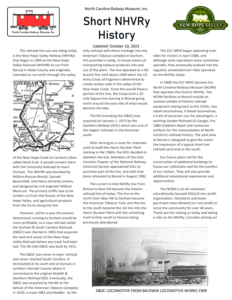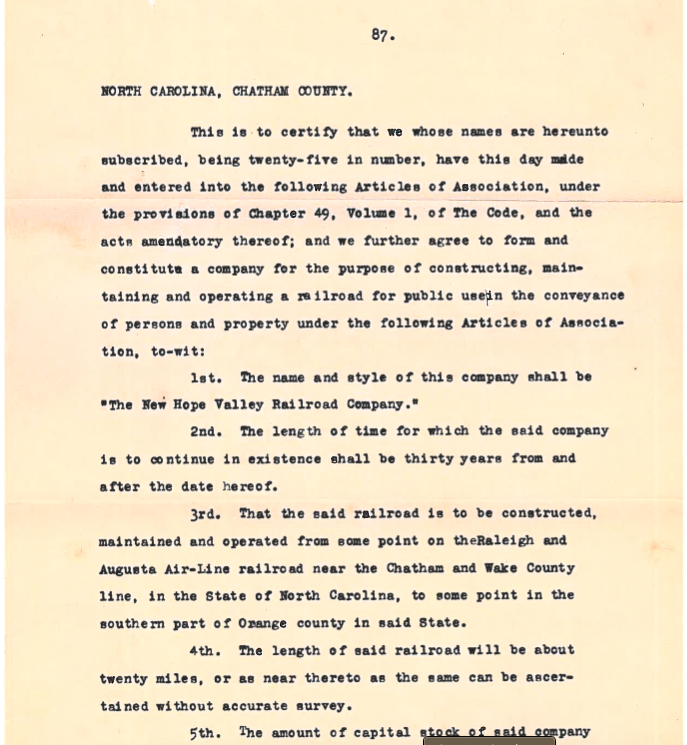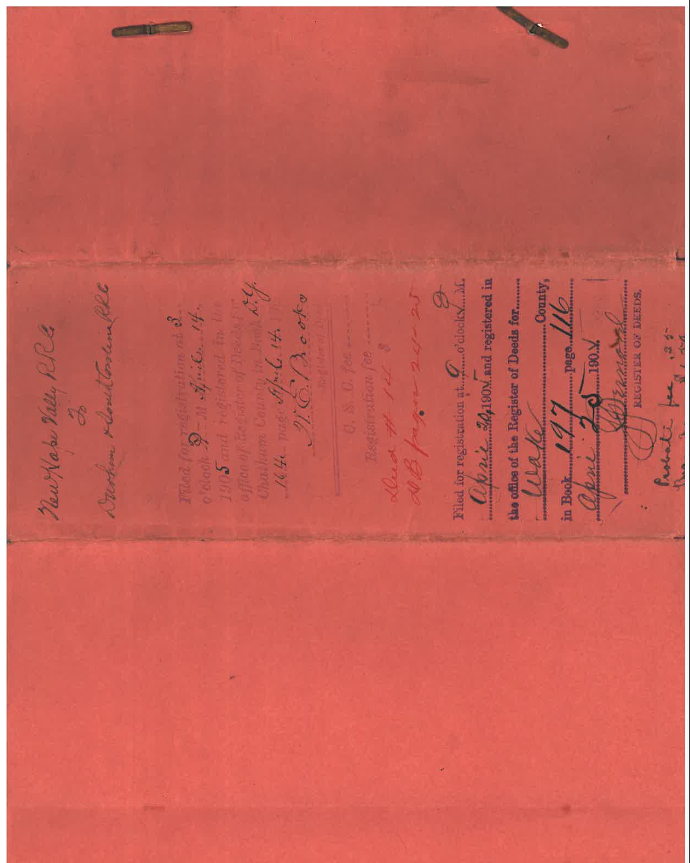The Early Years: 1900-1957 In 1904, a group of investors led by William Roscoe Bonsal sought to build a 20 mile railroad from Bonsal, NC (named after Mr. Bonsal) to West End, NC (now known as Carrboro). At the time, Mr Bonsal was also a Vice President of the Raleigh and Augusta Air Line Railroad (which consolidated with 20 others into what became the Seaboard Air Line) with a mainline that passed thru Bonsal (a little more than 20 miles southeast of Raleigh, NC). It was envisioned that this new railroad would provide access to an important railroad tie exchange in West End. These railroad ties could be of great use as the railroad expanded its lines across North Carolina. As the new railroad was to pass thru the valley of New Hope River basin, it was to be called the “New Hope Valley Railroad Company”. 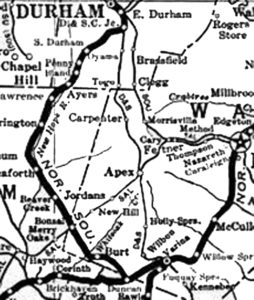 However, after securing land rights to build the New Hope Valley Railroad but before laying any track, Mr. Bonsal, and his investors in less than a year merged their planned railroad with another group of railroad investors. These new investors were affiliated with the American Tobacco Company (ATC) in Durham, and the “old” Norfork and Southern Railroad (N&S). It was envisioned that the merged line would travel 30 miles from Durham to Bonsal, then continue on an additional 10 miles southeast to Duncan, NC where the N&S had a mainline running between Raleigh and Charlotte, NC. The new 40 mile line was named the Durham & South Carolina Railroad (D&SC).
However, after securing land rights to build the New Hope Valley Railroad but before laying any track, Mr. Bonsal, and his investors in less than a year merged their planned railroad with another group of railroad investors. These new investors were affiliated with the American Tobacco Company (ATC) in Durham, and the “old” Norfork and Southern Railroad (N&S). It was envisioned that the merged line would travel 30 miles from Durham to Bonsal, then continue on an additional 10 miles southeast to Duncan, NC where the N&S had a mainline running between Raleigh and Charlotte, NC. The new 40 mile line was named the Durham & South Carolina Railroad (D&SC).
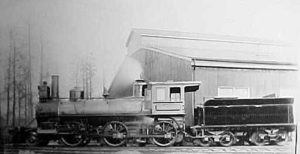
Ten-Wheeler Locomotive (4-6-0) built in 1905 by the Baldwin Locomotive Works in Philadelphia for the D&SC.
While the line never reached South Carolina, the entire 40 miles of track were built quickly and cheaply with manual labor, mules, and late 1880’s used, low grade rail with ties mostly laid directly on the ground with little ballast or drainage. The D&SC began initial operations between Durham and Bonsal by 1906, and on to Duncan within another year or so. There exists today a gas station in Duncan with an old fashion looking building as its store. That building was originally built as the D&SC’s Duncan depot, and relocated to the gas station’s current location after the line was abandoned. The D&SC was the only railroad with tracks into the American Tobacco factory in Durham. The N&S was encouraged to acquire the D&SC at the request of one of its major shareholders, the ATC, which sought to secure a ready, in-house means of transporting tobacco in and out of their factory. By 1920, the entire D&SC was “leased” by the N&S. As the surrounding land opened up to more farming, the D&SC also carried agricultural products such as cotton, corn and, lumber. Passengers were accommodated on a single mixed train, connecting with the N&S in Duncan, the SAL in Bonsal, and other rail lines in Durham. Given the originally very poor track work, derailments were commonplace which necessitated running trains very slowly. The line continued to be called the D&SC until 1957 at which time it was officially absorbed into the N&S, and often known subsequently as the N&S’s Durham & Duncan branch. To see the New Hope Valley Railroad’s 1904 charter, and merger with the Durham & South Carolina Railroad in 1905 please see the documents at the bottom of this page.
The Later Years: 1958-1982 The N&S continued to operate the former D&SC as a freight only branch line into the 1960s and 1970s. But with the ever-worsening track condition, and dwindling freight revenues the line became an increasingly likely candidate for abandonment. During this period, the U.S. Army Corps of Engineers began implementing a flood control project to help protect eastern North Carolina from extensive flooding such as experienced from a severe hurricane in 1945. In April 1969, the Army Corps of Engineers entered into a relocation agreement with the D&SC to move the rail line from the New Hope River basin to higher ground in preparation for the building of the New Hope Dam and Reservoir, later known as Jordan Lake. The new line branched off the old one about 1000 feet south of what is now I-40 at a place called Penny, which is very near the South Point shopping center and rejoined it in Bonsal in Wake County. The new “bypass” line was completed in late 1973. On January 1, 1974, the N&S was acquired by the Southern Railway (SOU). The SOU was one of the largest railroad systems in the south at the time. The New Hope Reservoir was filled and the new 20 mile “bypass” line constructed by the Army Corps of Engineers was turned over to the Southern Railway in March. The acquisition made the line redundant to SOU and its future was grim. The line further to the southeast to Duncan had fallen into disrepair and had been abandoned a number of years earlier. Around 1979 Southern started the process to formally abandon the line and planned to remove the track between Durham and Bonsal. Use of the line was very limited, but a few trains operated over the line and use continued on part of the line to the southeast from Bonsal, to deliver materials to build Shearon Harris Nuclear Plant.
A New Beginning: 1982-Present Day In 1982, a group of individuals who had worked together for nearly 20 years on rail history and preservation projects known as the 501(c)3 non-profit East Carolina Chapter of the National Railway Historical Society (ECC NRHS) learned about SOU’s plans to abandon the line between Bonsal and Durham. By pooling together their own personal funds that they had contributed or borrowed, they were able to purchase a portion of the line from the SOU to preserve and allow its future operation as a historic railroad. This included the property and rail yard in Bonsal, a little over 4 miles of the new “by-pass” line to New Hill, and a nearly one mile portion of the “old” line from Bonsal to Durham that still remained not flooded by Jordan Lake. In August 1982, the SOU delivered to New Hill via Durham a collection of historic railroad equipment and locomotives that the ECC NRHS had previously maintained in Farmville, NC. The SOU also donated two box cars to the collection. Only a few days later, the SOU disconnected the track at New Hill north to Durham. Leaving the ECC NRHS with a “land-locked” railroad with no rail access to any other railroad. Some years later, that remaining property and old railbed starting a mile or so north of New Hill became the southern end point for the American Tobacco Trail. From there, the American Tobacco Trail follows the railbed north all the way into downtown Durham. Out of respect for the history of Mr. Bonsal and his fellow investor’s plans for building the New Hope Valley Railroad in 1904, the ECC NRHS group decided to name their historic railroad line the New Hope Valley Railway (NHVRy). During those early years, the line also earned the nickname “The Lightnin’ Bug Route” because when ECC NRHS volunteers worked into the evening hours, they noticed hundreds of fireflies lighting up the area. All volunteer-operated train rides first started in the spring of 1984 with a somewhat sporadic schedule. See below for mentions of our first “Open House” train rides in 1984 in two issues of our member newsletter “The Tarheel Telegrapher”. That was way before we started selling tickets for train rides. Back then we just asked riders to make a donation for a train ride. But those early donations made all the difference to help us get started and become the operation we are today. Over time, with more equipment acquired and restored for train rides, and a larger group of volunteers, train rides became more routine and generally offered a couple days each month between April and December. In 2008, the ECC NRHS became the 501(c)3 non-profit North Carolina Railway Museum, Inc. (NCRM), and still operates the NHVRy today as an important part of its mission to preserve and share with the public North Carolina’s railroad history. In more recent years, the NHVRy has also become known more affectionately as the “Triangle’s Train”.

